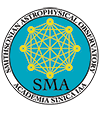|
Why do Massive Stars form only in massive clusters?
While low-mass stars form in clusters of sizes from a few to many thousands of stars, young high-mass stars are always found at the centers of large clusters, with the exception of runaway stars ejected by close encounters in cluster centers. Is the cluster environment essential to the formation of massive stars? Why are massive stars always observed in the center? Do the high mass stars form there, do they migrate there, or are they found there simply because there are more stars in the center and thus a greater probability of one or more massive stars? Are the accompanying low mass stars formed first, induced into formation by the high mass stars, or does star formation terminate after the formation of the first massive stars?
Observers have used the high angular resolution of the SMA to study massive young clusters in their earliest stages of formation (Fontani et al. 2008; Beuther et al. 2007; Zhang et al. 2007; Hunter et al. 2006). Of particular interest are the young clusters made up not of young massive stars but of the dense, dusty cores that are the pre-cursors to massive protostars. These observations indicate the initial conditions and determine which characteristics of the cluster are imprinted at formation and which derive from further evolution. SMA dust and molecular line observations find conditions in protoclusters that are similar to those of the much more evolved Orion Trapezium, velocity dispersions of a few kms-1 and separations between the high-mass members of a few 104 AU.

Click here for larger view
| Figure 2: SMA 1 mm continuum (image and white contours) of the protocluster NGC6334I showing a cluster of dense dusty cores. The symbols show H2O and CH3OH masers and mid-IR sources indicative of massive protostars. An HII region (purple contours of 3.6 cm continuum) indicates one or more stars of mass > spectral type B0. The lack of 3.6 cm continuum in the other cores indicates that the protostars are too young or not yet massive (hot) enough to produce significant ionizing radiation. (Hunter et al. 2006). |
» Next Page: What governs protostellar mass accretion?
« Previous Page
SMA Research
| 

